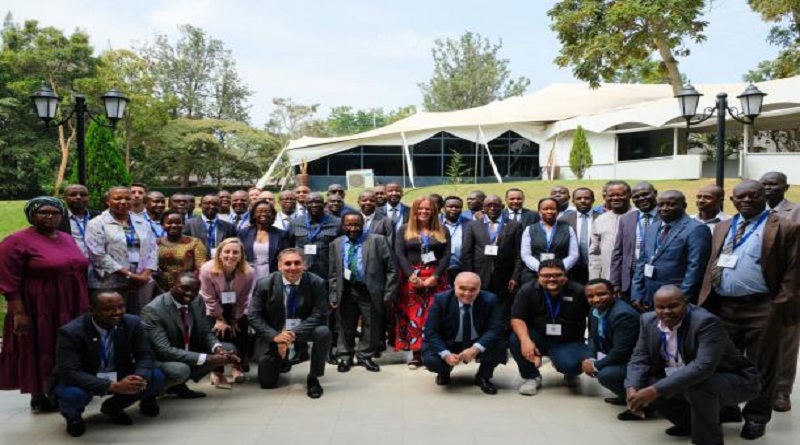Groups launch $7m climate risk and early warning systems initiative in East Africa
The World Meteorological Organization is supporting a new regional project to strengthen hydro-meteorological services and early warnings in six countries in East Africa and around Lake Victoria to build resilience and support climate change adaptation.
More than 60 representatives from the National Meteorological and Hydrological Services (NMHSs) and National Disaster Management Offices of Burundi, Kenya, Rwanda, South Sudan, Tanzania and Uganda met in Kigali, Rwanda, on 12 June to launch the US$7 million Climate Risk and Early Warning Systems Initiative (CREWS) East Africa project.
The project is jointly implemented by WMO, the UN Office for Disaster Risk Reduction and the World Bank. It will scale up Early Warning Services (EWS) for Early and Anticipatory Actions (EWS-EAA) by building capacities of countries and regional institutions towards impact-based, people-centred weather predictions and warnings, specific to national and local context.
“In the face of increasing climate uncertainty, the importance of Early Warning Systems cannot be overstated. They are the cornerstone of our preparedness and response efforts … in protecting lives, safeguarding livelihoods, and building resilient communities across Africa,” said the UN Resident Coordinator for Rwanda, Dr Ozonnia Ojielo.
“The CREWS project aligns with and supports the ambition of the global Early Warning for All (EW4All) initiative announced by the UN Secretary General at COP27. We are glad that, in Africa, 13 countries have been chosen to pilot this initiative. EW4All envisions a world where every person, starting with the most vulnerable, has access to timely and accurate early warnings by 2027. This will require strengthening of national systems and capacities to deliver early warning services. By launching the CREWS project, we reaffirm our commitment to this vision, ensuring that the benefits of early warning systems are accessible and inclusive. We must prioritize the needs of vulnerable populations, to leave no one behind in our resilience efforts,” said Dr Ojielo.
The Rwanda Meteorological Agency and its director, Aimable Gahigi, hosted the event, which highlighted key priorities:
The need to align national and regional activities, leveraging existing capacities and maximizing shared value from them;
The need to combine projects, investments, and capacities in the region for effective implementation; and
The importance of ensuring last-mile EWS activities related to appropriate, and timely action on the ground are implemented.
East Africa has a diverse terrain and climate, which, over the years, has made it more susceptible to weather- and climate-related impacts caused by natural hazards such as floods, droughts, landslides and other severe hydro-meteorological phenomena. Lake Victoria, Africa’s largest lake, heavily influences weather and climate conditions in East Africa, generating its own micro-climate as one of the most convectively active regions on earth. Countries in the Lake Victoria Basin (LVB) are often affected by severe thunderstorms, heavy rainfall, strong winds, high waves, lightning, hailstorms and waterspouts. The Lake, bordered by Kenya, Tanzania and Uganda, supports approximately 25% of its surrounding population, mainly fisherfolk.
An ensuing four-day technical workshop took a bottom-up approach, with beneficiary countries presenting their institutions’ current gaps, challenges, and priorities.
Implementing partners hosted working sessions on forecasting and early warnings, socio-economic cost benefits, mainstreaming gender inclusion, monitoring and evaluation, Impact-Based Early Warning Services and more.
Key takeaways include:
Forecasting and early warning capacities must be improved and on par across the region;
The establishment of multi-hazard early warning systems that cover a variety of hazards aside from floods is needed;
International data and information exchange need be addressed;
Improved cooperation and collaboration between NMHSs and national disaster management agencies is needed to better integrate risk data in early warnings;
Capacity development of human resources is necessary in all areas, but most urgently for forecasting, operations and maintenance of observing networks;
Funding is necessary to ensure longevity and sustainability of activities;
User engagement and increased awareness of Early Warnings amongst the public must be improved. There are currently no fully developed and operational systems in that integrate all MHEWS components to ensure end-to-end early warnings reach the most vulnerable, last mile.
Several next steps to ensure successful implementation of the project were identified, with the first being individual consultations with the beneficiary countries to develop detailed workplans for validation ahead of the commencement of activities.
Activities being undertaken through the project are aligned with CREWS value propositions and core programme indicators, which will demonstrate concrete impacts of the project. They are further aligned with the Early Warnings for All Initiative.




